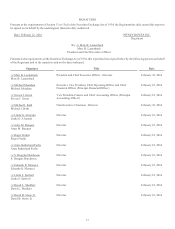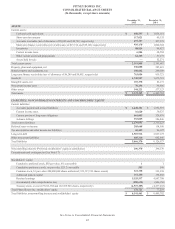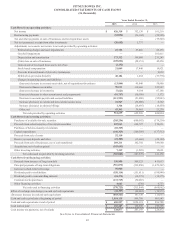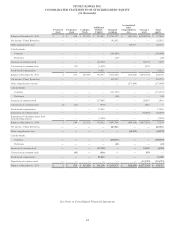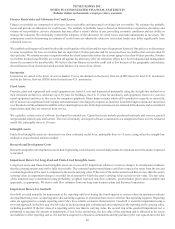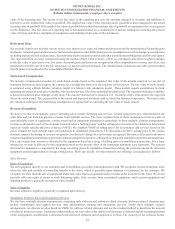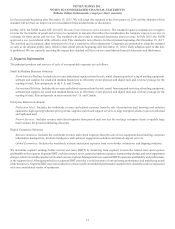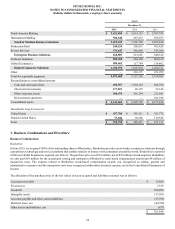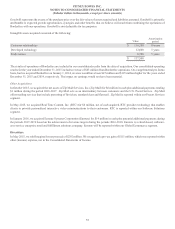Pitney Bowes 2015 Annual Report Download - page 61
Download and view the complete annual report
Please find page 61 of the 2015 Pitney Bowes annual report below. You can navigate through the pages in the report by either clicking on the pages listed below, or by using the keyword search tool below to find specific information within the annual report.PITNEY BOWES INC.
NOTES TO CONSOLIDATED FINANCIAL STATEMENTS
(Tabular dollars in thousands, except per share amounts)
45
1. Summary of Significant Accounting Policies
Basis of Presentation
The accompanying Consolidated Financial Statements of Pitney Bowes Inc. (we, us, our, or the company) and its wholly owned subsidiaries
have been prepared in conformity with accounting principles generally accepted in the United States of America (GAAP). Intercompany
transactions and balances have been eliminated. Certain prior year amounts have been reclassified to conform to the current year
presentation.
As a result of the acquisition of Borderfree, Inc. (Borderfree) in June 2015 and the sale of our Marketing Services business, Imagitas, in
May 2015 (see Note 3), we realigned our segment reporting to conform to the way we now manage our segments and recast prior period
amounts to conform to the current year presentation (see Note 2). Our business continues to be organized around three distinct sets of
solutions – Small and Medium Business (SMB) Solutions, Enterprise Business Solutions and Digital Commerce Solutions (DCS). Under
the new segment reporting, there were no changes to SMB Solutions or Enterprise Business Solutions; however, within DCS, our Software
Solutions operations and Global Ecommerce operations are reported as reportable segments. The Other segment is comprised of Imagitas.
Imagitas was previously reported in DCS.
Use of Estimates
The preparation of financial statements in conformity with GAAP requires the use of estimates and assumptions that affect the reported
amounts of assets, liabilities, revenues, expenses and accompanying disclosures, including the disclosure of contingent assets and
liabilities. These estimates and assumptions are based on management's best knowledge of current events, historical experience and other
information available when the financial statements are prepared. These estimates include, but are not limited to, revenue recognition for
multiple element arrangements, the allocation of purchase price to tangible and intangible assets acquired and liabilities assumed in
business combinations, goodwill and intangible asset impairment review, allowance for doubtful accounts and credit losses, residual
values of leased assets, useful lives of long-lived and intangible assets, restructuring costs, pensions and other postretirement costs, income
tax reserves, deferred tax asset valuation allowance, stock-based compensation expense and loss contingencies. Actual results could differ
from those estimates and assumptions.
Cash Equivalents and Short-Term Investments
Cash equivalents include liquid investments with maturities of three months or less at the date of purchase. Short-term investments include
investments with a maturity of greater than three months but less than one year from the reporting date.
Investment Securities
Investment securities that management has the positive intent and ability to hold to maturity are classified as held-to-maturity and are
carried at amortized cost. Investment securities not classified as held-to-maturity are classified as available-for-sale and recorded at fair
value, with unrealized gains and losses reported in other comprehensive income, net of tax. Purchase premiums and discounts are
recognized in interest income using the effective interest method over the term of the security. Gains and losses on the sale of available-
for-sale securities are recorded on the trade date and are determined using the specific identification method. Investment securities are
recorded in the Consolidated Balance Sheets as cash and cash equivalents, short-term investments and other assets depending on the
investment's maturity.
Accounts Receivable and Allowance for Doubtful Accounts
We estimate the probable losses on accounts receivable and provide an allowance for doubtful accounts. The estimate of probable losses
is based on historical loss experience, aging of receivables, adverse situations that may affect a client's ability to pay and prevailing
economic conditions. We continually evaluate the adequacy of the allowance for doubtful accounts and make adjustments as necessary.
The assumptions used in determining an estimate of probable losses are inherently subjective and actual results may differ significantly
from estimated reserves.
Accounts receivable are generally due within 30 days after the invoice date. Accounts deemed uncollectible are written off against the
allowance after all collection efforts have been exhausted and management deems the account to be uncollectible. We believe that our
accounts receivable credit risk is low because of the geographic and industry diversification of our clients and small account balances
for most of our clients.




